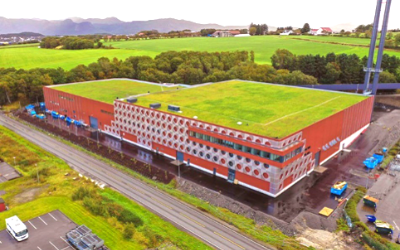Case study about a MSW sorting facility in Norway – IVAR
This report explores lessons on sorting technologies for waste in the field of material and energy valorisation of waste within the framework of IEA Bioenergy Task 36. The purpose of this report is to showcase examples from which countries can get inspiration and support in implementing solutions in the waste/resource management and Waste-to-Energy sector that would facilitate their transition towards circularity.
There is a global urge for CO2 emissions mitigation and Waste-to-energy (WtE) incineration plants are pointed out as an important source with potential for improvement/reduction. It is estimated that for each tonne of waste burned, 0.7 to 1.7 tonnes of CO2 are released depending on the type of waste feedstock. Fossil-derived plastics account for a significant part of the waste incinerated and, therefore, are responsible for a substantial part of the fossil CO2 emissions from the incineration plants. The main solutions envisaged so far to reduce these emissions are (1) upstream – promoting plastic source separation to reduce the amount of fossil-based waste in MSW and (2) downstream – Carbon Capture Storage (CCS) and Carbon Capture Utilization (CCU) technology to retains both the bio- and fossil-CO2 in the flue gas emitted by the plants. An intermediate solution to these is the implementation of advanced waste sorting systems prior to the incineration plant. It is noteworthy that all alternatives are compatible and could complement each other.
This report presents an example of a mixed waste sorting facilities in Norway where the process facilitates material recovery prior to incineration.
The full report is available here:
Case study about a MSW sorting facility in Norway – IVAR
The IVAR Forus plant in southwestern Norway combines post-sorting of residual waste with recycling of some of the plastic waste fractions. At the plant five different fraction of plastics, four fractions of paper, bio-waste, glass, and metal packaging are separated by using near infra-red technology (NIR). In total 83.2 % by weight of the incoming waste is sent to energy recovery (WtE) and 16.8 wt% is recovered for material recycling. It is estimated that approx. 82 wt% of the plastic in the waste is separated. Today they also have spare capacity to receive more waste for sorting, however the costs are relatively high and the economic incentive from the sales of the sorted materials are not enough. The largest renumeration comes from the Norwegian producer responsibility schemes for sorting plastic, metal packaging and beverage cartons.
The bottleneck of the recycling industry with the current state of the art is the quality of the plastic waste. Only half of the recovered plastic waste is suitable for mechanical recycling. New solutions for both plastic sorting and recycling are needed to increase the impact and circularity from the recycling. It will be crucial to find solutions for low quality and mixed plastic materials. There also need to be measures put in place to create a market pull for the recycled material.
While all the recycled material generates positive climate effects, the recycled plastic generates double gains. It reduces the emissions to produce virgin plastics and at the same time it reduces the direct fossil CO2 emissions generated by the WtE plant. Considering upcoming regulations in Norway, with increased CO2 taxes, the investments for more residual sorting plants in Norway is likely to increase.



